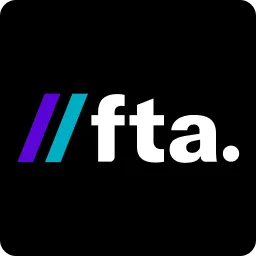Adapting to the AI Era - Optimizing for E‑E‑A‑T in a New Digital Landscape
1 The AI‑driven digital landscape
Search is no longer static. It is generative as well as multi-modal. Google is not just indexing pages; it is evaluating experience, context and intent. This shift has changed how content is discovered, ranked and trusted.
At the centre of this disruption is Google's E-E-A-T policy, which stands for Experience, Expertise, Authoritativeness, and Trustworthiness.
It is not a new formula, but its role has changed. These are no longer abstract editorial ideals. They now inform how Google’s AI systems measure content quality and filter visibility.
What’s at Stake for Brands?
The rise of AI-generated search summaries, stricter E-E-A-T enforcement, and MUVERA signals isn’t just a tech update. It’s already disrupting how B2B buyers discover, trust, and engage with brands.
If your content isn't aligned:
- You may lose up to 50% of organic clicks due to AI Overviews replacing traditional results.
- Your top-ranking pages could be demoted if they lack real expertise, author bios, or helpful formatting.
- Poorly structured content won't train Google’s models effectively, causing your brand to vanish from high-value search journeys.
Traffic, leads, and authority are now earned through experience-first content.
Brands stuck in outdated SEO habits risk erosion of trust, reduced visibility, and lower content ROI.
“E-E-A-T isn’t new, but the added focus on experience pushes content quality to the next level. At FTA Global, we ensure every blog reflects real client scenarios, includes process checklists, uses tool screenshots, and links back to our team’s LinkedIn profiles or other relevant profiles.
Hence, the content isn’t just informative, it’s lived, proven, and trustworthy. As VP of Branding at FTA, this means prioritizing content for our audience that builds credibility, showcases our team’s expertise, and turns every piece into a brand trust asset for our readers.” - Srjita Das Roy, VP-Branding, FTA Global
Key Takeaways
- E-E-A-T now includes ‘Experience’ as a core signal. Google rewards content backed by first-hand knowledge, direct product use, or on-the-ground reporting.
- Responsible AI drives results. Microsoft saw a 75% boost in trust signals and moved from #10 to #4 in search rankings by aligning with E-E-A-T standards.
- SGE is reshaping content discovery. To appear in AI-generated search results, content must be structured, rich in detail, and supported by quality visuals. Content is now a multi-format production to cater to an AI-aware audience.
- An E-E-A-T checklist is essential. Define audience, show expertise and experience, cite sources, disclose AI, maintain site health, and update continuously.
- Scaled content and site reputation abuse are being penalised. Google’s 2024 update targets low-value mass content and third-party publishing that misuses domain authority.
- Google’s search signals are now intent-driven and context-aware. With MUVERA and other AI-led ranking systems, content relevance is judged across multiple vectors. It's no longer about keywords alone; it's about matching user intent with trustworthy context.
- AI governance is still lacking at leadership levels. With only 14% of global boards regularly discussing AI, marketers must push for responsible adoption aligned with their frameworks.
- Brands must treat content as a strategic asset, not a volume game. The shift from output to impact means marketers must align strategy with business goals, audience value, and measurable trust signals across every touchpoint.

AI-generated content is flooding the web. Brands are scaling production with automation. But Google’s 2025 updates are designed to punish scaled content, low-value pages, and third-party domain misuse.
Algorithms like MUVERA are pushing relevance deeper into semantic territory, comparing content across multiple vectors rather than matching keywords.
Meanwhile, Google’s evolution is visible through:
- BERT* improved contextual understanding
- MUM* brought multimodal reasoning
- SGE* is rewriting how users interact with search entirely.
From sidebars to snapshots to suggested follow-ups, the search result itself has become a generated experience.
For marketing leaders, this creates a dual challenge: keeping up with rapid algorithmic changes and responding with content that performs under new quality standards.
First-hand reviews, structured visuals, expert authorship and other production methods are replacing static blogs, templated advice, and SEO-stuffed landing pages.
This whitepaper outlines how brands, publishers and agencies should respond. It decodes what has changed in the last five years, what Google now rewards, and what a future-proof content strategy looks like.
Whether you're leading a marketing function or advising clients, understanding how to optimise for E-E-A-T is now central to staying competitive in the AI age.
Glossary
- BERT – A neural language model introduced by Google that analyses the context of words by looking at the words before and after them, improving understanding of conversational queries. Google Blog
- MUM – Google’s Multitask Unified Model uses a multimodal transformer to understand and generate language across 75 languages and different media, enabling richer search experiences. Google Blog
- Search Generative Experience (SGE) – An experimental interface in Google Search that uses generative AI to produce summaries and enable conversational exploration. Google Blog
2. What’s changed in the last decade?
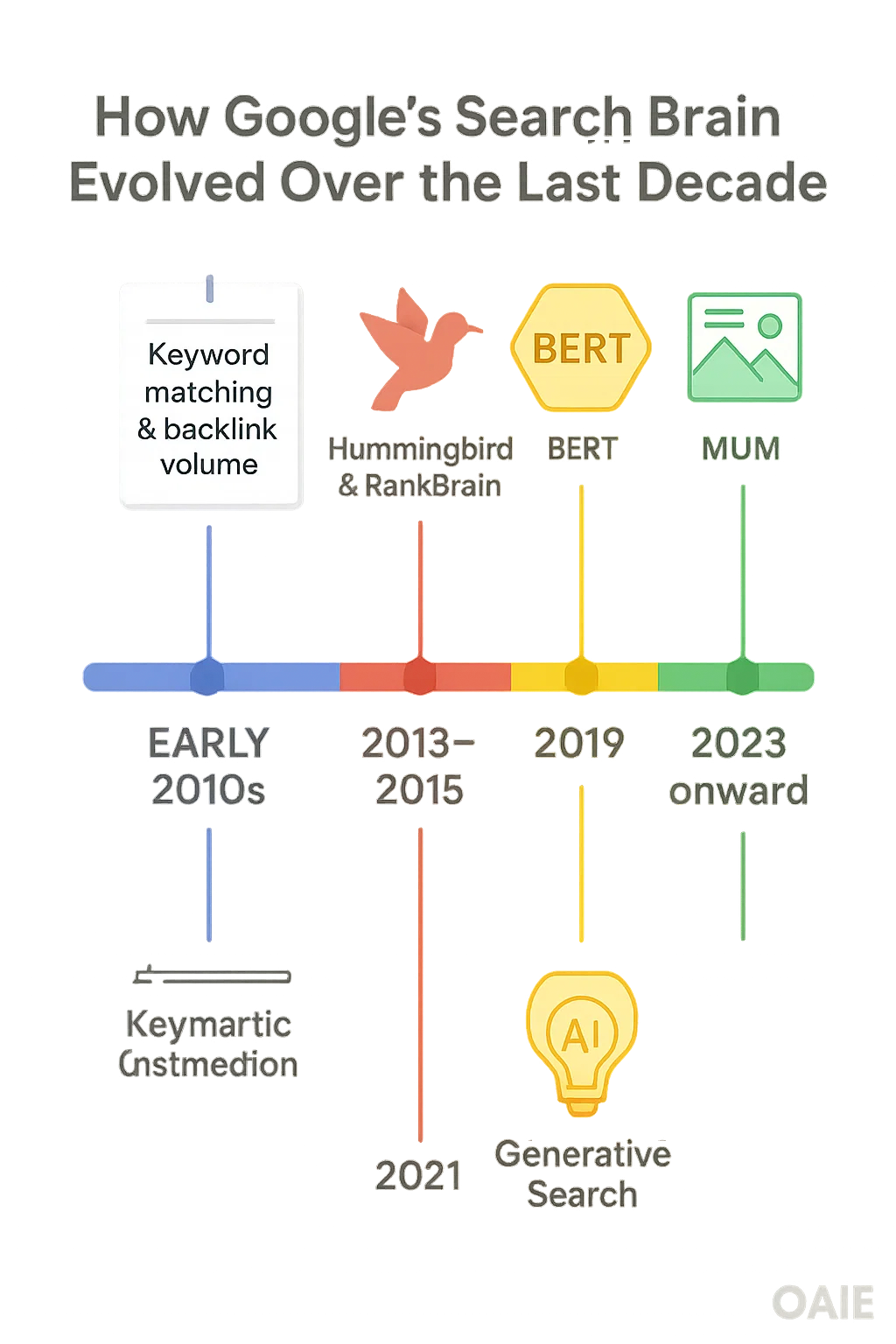
2.1 How Google’s Search Brain Evolved Over the Last Decade?
- Early 2010s: Search relied on keyword matching and backlink volume to rank content.
- 2013–2015: Hummingbird and RankBrain introduced semantic understanding and machine learning to interpret intent.
- 2019: BERT enabled full-context language processing, improving how Google understands natural queries.
- 2021: MUM brought multimodal reasoning, combining text and visuals to answer complex, layered questions.
- 2023 onward: Generative Search (SGE) reshapes results into AI-generated summaries, raising expectations for depth, clarity and format-rich content.
2.2 User experience becomes integral
Google’s page experience update (June 2021) introduced Core Web Vitals metrics measuring loading performance, interactivity and visual stability as ranking signals.
Sites with fast load times, stable layouts and responsive design gained a competitive edge.
The rollout of mobile-first indexing further emphasised the need for accessible, secure, and mobile-friendly experiences.
Marketers had to move beyond textual optimisation to address design, usability and technical performance.
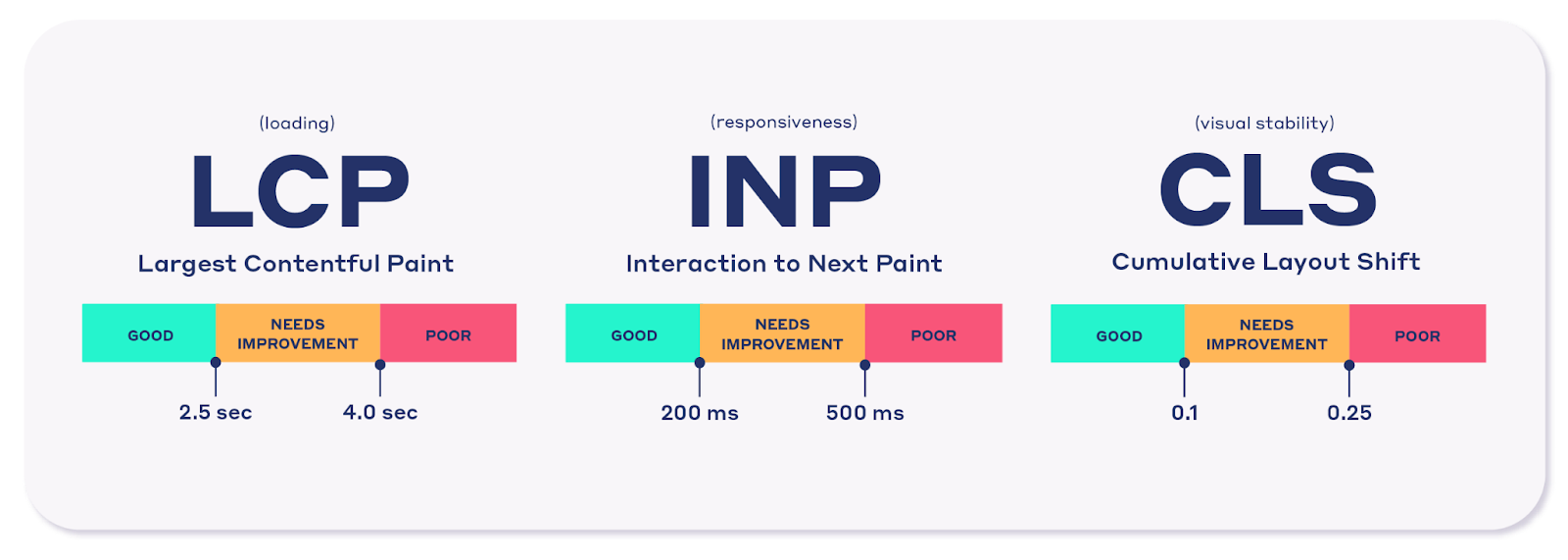
Glossary
- Core Web Vitals – A set of metrics measuring loading performance (Largest Contentful Paint), interactivity (First Input Delay) and visual stability (Cumulative Layout Shift) used by Google to evaluate page experience. Web.dev
- YMYL – An acronym for “Your Money or Your Life,” describing topics that could impact a person’s finances, health or safety; such pages are held to higher quality standards. Google Developers
2.3 Helpful content and anti‑spam policies
In August 2022, Google launched the helpful content update, a machine‑learning classifier that identifies and demotes content that fails to provide a satisfying experience.
The update encourages creators to focus on people‑first content rather than generating pages primarily to attract search traffic.
The April 2024 spam update strengthened enforcement against scaled content abuse, site reputation abuse and expired domain abuse.
3. Why did Google expand E‑A‑T to E‑E‑A‑T?
Google first introduced E‑A‑T (Expertise, Authoritativeness, Trustworthiness) in its Search Quality Rater Guidelines to help evaluate content quality.
Over time, generative AI, misinformation, and zero-click experiences made surface-level optimisation insufficient.
Google responded by elevating the bar, adding “Experience” as a fourth dimension, transforming E‑A‑T into E‑E‑A‑T.
3.1 Why the shift?
- The rise of AI-generated content and zero-click results created a gap between surface-level accuracy and real insight.
- Google introduced “Experience” to ensure content is not just factually correct, but also rooted in real-world, lived knowledge.
- The framework now values content that demonstrates first-hand involvement, not just theoretical repackaging.
3.2 Breakdown of E‑E‑A‑T
Experience
- Content should reflect direct involvement, observation or use, not just summaries of other sources.
- In high-stakes topics like finance or health, first-hand experience must be paired with citations and disclaimers.
Expertise
- Demonstrated through qualifications, professional practice or deep domain knowledge.
- Should be visible via author bios, credentials, case studies or evidence-based insights.
Authoritativeness
- Earned through recognition from other credible sources, backlinks, citations or institutional affiliations.
- Strengthened by publishing consistently high-quality, topic-relevant content over time.
Trustworthiness
- Built through transparency, factual accuracy, ethical disclosures and secure environments.
- Reinforced by clear sourcing, disclosure of AI use, privacy compliance and technical reliability.

3.3 The “Who, How, Why” framework
To operationalise E‑E‑A‑T, Google recommends asking three core questions:
- Who created the content? Identifying the author and their credentials helps readers and algorithms gauge expertise and accountability.
- How was the content produced? Google suggests adding metadata and describing the editorial process.
- Why does the content exist? Clarifying whether the purpose is to inform, entertain or sell ensures alignment with user intent.
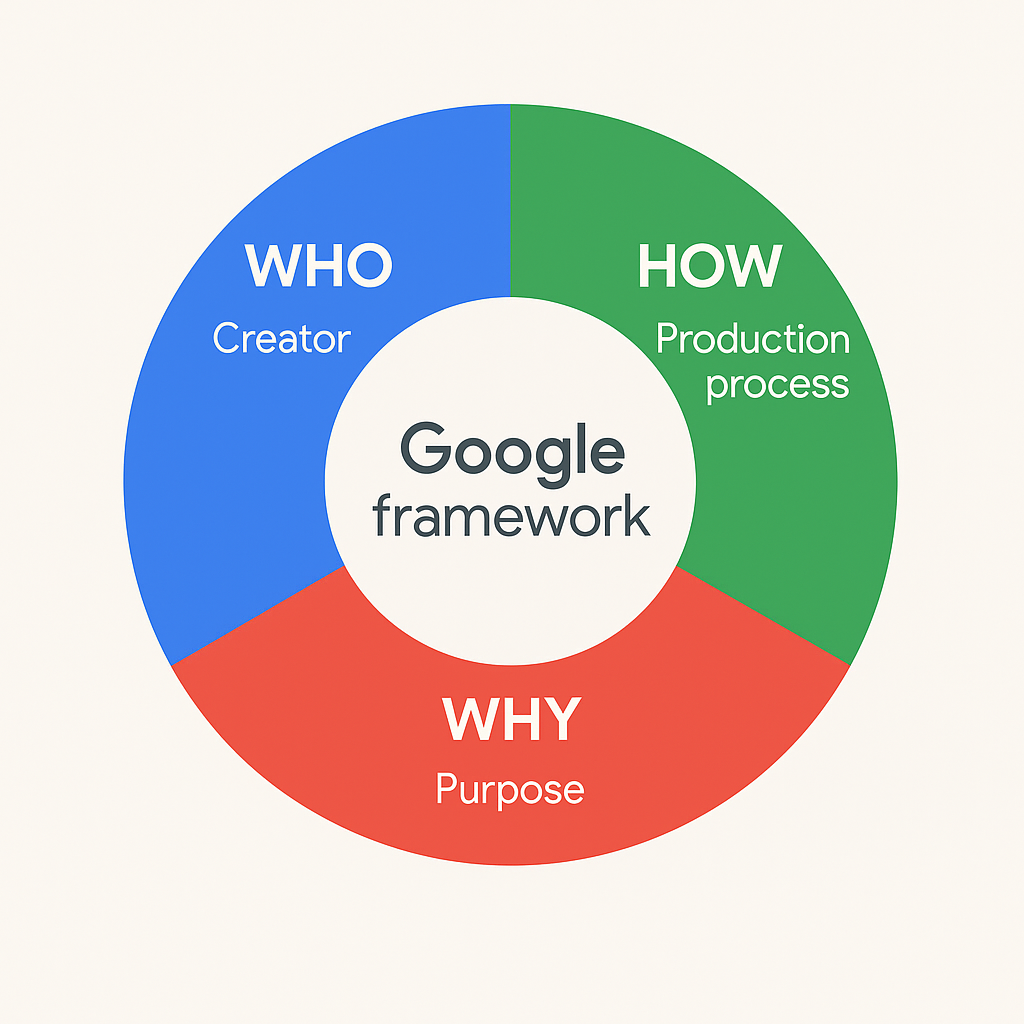
3.4 Is there a connection between E‑E‑A‑T and YMYL?
Topics affecting finances, health, safety or well‑being, called YMYL (Your Money or Your Life) are subject to heightened scrutiny. Google explicitly states that YMYL pages demand strong E‑E‑A‑T signals.
For example, financial advice should be authored by certified professionals and include risk disclosures; medical information should cite peer‑reviewed studies and regulatory guidelines. Publishers operating in these sensitive areas should prioritise rigorous fact‑checking, expert review and transparent governance.
4 Implications for brands, publishers and marketers
4.1 What it means for brands
Brands today compete on trust. Anonymous or low-effort content is easily spotted and penalised.
Brands must therefore:
- Invest in authenticity. Highlight first‑hand product tests, case studies and customer stories.
For example, when Apple launched the M1 chip, it didn’t rely solely on product specs. It published in-house performance benchmarks and showcased internal testing videos by Apple engineers.
- Train internal subject‑matter experts. Encourage engineers, clinicians, lawyers or financial advisors to contribute content.
- Disclose AI assistance. When generative tools help draft or translate content, brands should explain this in an ‘About this article’ section.
- Establish content governance. Brands need to set standards for authorship, sourcing, accuracy, and tone.
4.2 Implications for publishers
Publishers face unique pressures: the demand for timely content, the need to monetise via ads and affiliates, and the temptation to outsource writing.
Publishers should:
- Enforce editorial oversight. Editorial teams must verify facts, review tone and ensure compliance with policies.
- Curate third‑party contributions. Sponsored posts, native advertising and guest articles must align with the site’s mission.
- Clean up legacy content. Conduct audits to identify content that duplicates others, lacks unique insights or no longer serves users.
- Diversify media. SGE and other AI experiences favour pages with structured data, images and videos. Publishers should invest in multimedia storytelling.
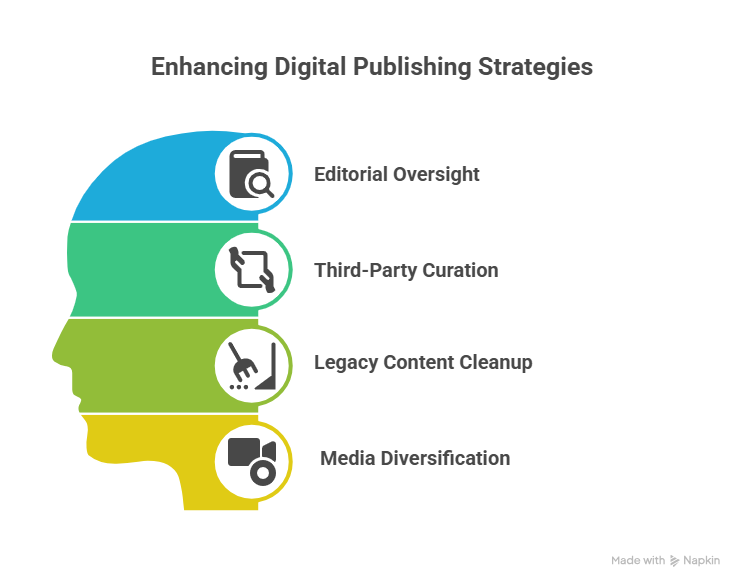
4.3 Implications for marketers
Marketers plan campaigns across channels, but SEO remains a cornerstone. With E‑E‑A‑T and generative AI, marketers should:
- Shift from keyword stuffing to intent matching.
- Use research tools to understand user goals and questions.
- Create comprehensive guides, how‑to articles and comparison pieces.
- Include personal anecdotes, expert commentary and data to satisfy both experience and expertise signals.
- Optimise technical fundamentals. Page speed, mobile responsiveness, accessibility and security are prerequisites. Lazy loading, efficient image formats and robust hosting contribute to Core Web Vitals performance.
- Leverage structured data. Implement relevant schema markup to help search engines interpret content. Structured data can enhance eligibility for rich results and inclusion in AI snapshots.
- Monitor AI search features. Use tools like Search Console and Keyword Planner to assess how generative experiences are affecting traffic.
- Align content with brand voice and ethics. AI can produce generic text, but differentiation comes from brand personality and values.
5. Timeline 2020–2025: Key Algorithm and Policy Milestones
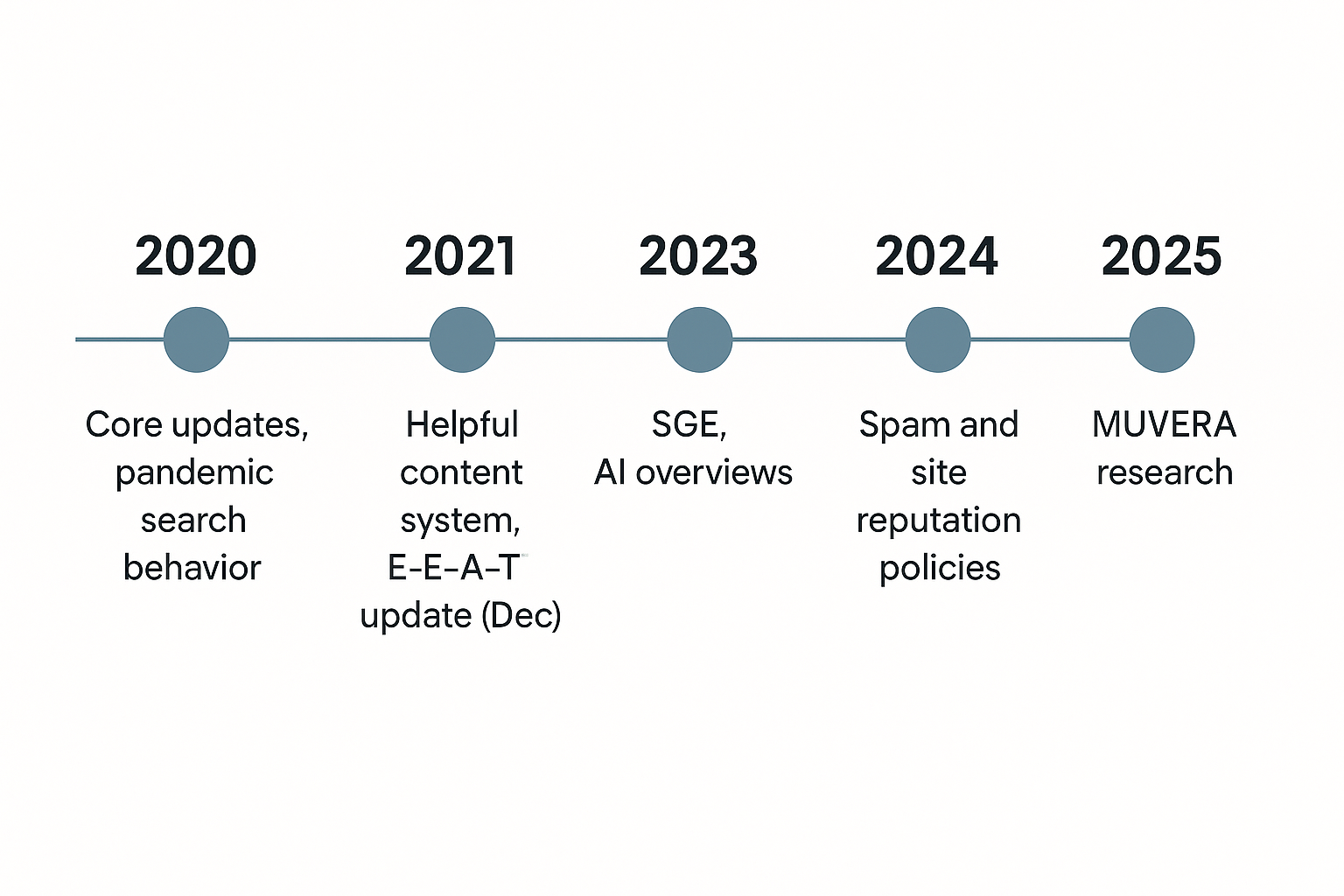
2020 – Core Updates and Pandemic Response
- Three core updates: January, May, December - refined ranking signals.
- Pandemic impact: Search behaviour shifted toward health, remote work, and online commerce.
- Winners: Sites offering timely, accurate pandemic content gained visibility and trust.
2021 – MUM and Page Experience Rollout
- MUM (May 2021): Enabled cross-language, multimodal understanding using text and images.
- Page Experience Update: Added speed, interactivity, and visual stability as ranking factors.
- Action for marketers: Optimise technical performance alongside quality content.
2022 – Helpful Content System and E-E-A-T
- Helpful Content Update (Aug): Site-wide signal penalising low-value, unhelpful content.
- E-A-T becomes E-E-A-T (Dec): 'Experience' added to prioritise first-hand, real-world insights.
- Recovery: Requires removal of weak content and a shift to people-first publishing.
2023 – SGE and Generative Overviews
- SGE launch (May): Introduced AI-generated snapshots and conversational search.
- Publisher impact: Structured data, visuals, and E-E-A-T signals became critical for visibility.
- Search journey: Shopping and Q&A features are integrated into the AI search flow.
2024 – Spam Policy Overhaul and Site Reputation
- Spam update (Apr): Targeted scaled content abuse, expired domains, and third-party publishing misuse.
- Site reputation policy (Nov): Manual actions for domains hosting unrelated or manipulative third-party pages.
- Guidance: Subsections must align with the site's purpose or be noindexed if risky.
2025 – MUVERA Research and Future Signals
- MUVERA (June): Multi-vector retrieval system using fixed-dimension encoding for better AI performance.
- Implication: Signals future algorithms focused on multimodal understanding and efficient scaling.
- Strategic takeaway: Structure and authenticity will drive future rankings in generative environments.
6. What brands are doing wrong?
Although many organisations recognise the importance of quality content, several recurring mistakes undermine E‑E‑A‑T signals and search visibility.
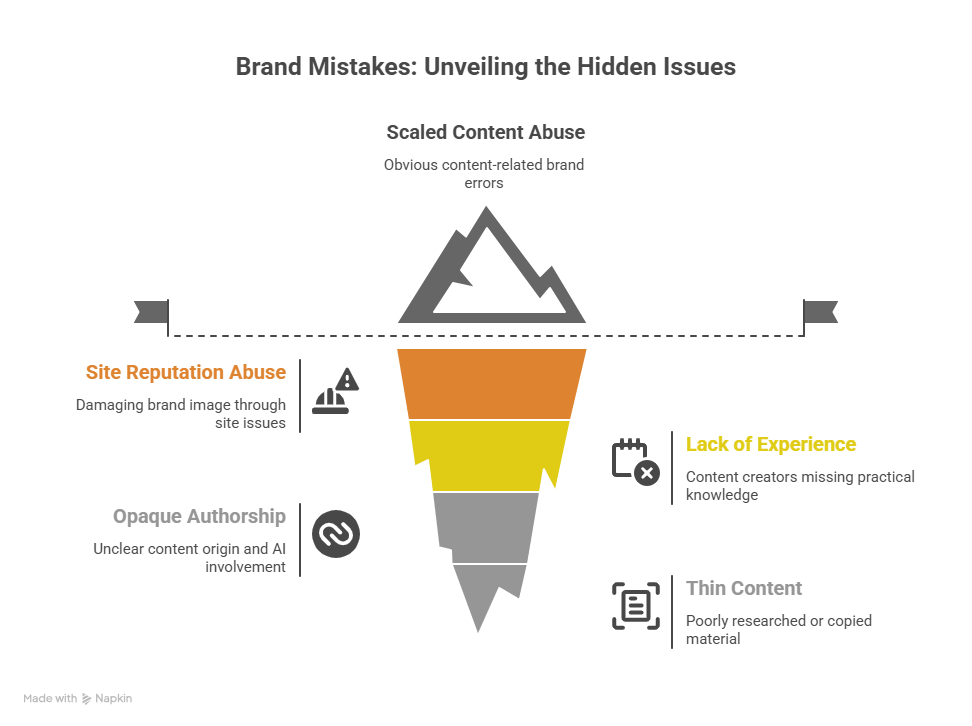
6.1 Scaled Content Abuse
- Brands use automation tools to mass-produce low-value pages, such as product descriptions with little to no variation.
- Example: Retailers autogenerate thousands of pages with copy-pasted specs from manufacturers. These pages fail to rank and are often flagged by Google’s spam systems.
6.2 Site Reputation Abuse
- Some companies host unrelated third-party content like gambling, coupons or payday loans to exploit their domain's authority.
- Example: In 2024, major news publishers were penalised for allowing subdomains with unrelated commercial content.
6.3 Lack of First-Hand Experience
- Content often lacks personal insight or expert review, especially when created by AI. This makes it untrustworthy.
- Example: CNET published AI-generated finance articles that included errors and misleading advice. Without human oversight or lived experience, content quality failed.
6.4 Opaque Authorship and Undisclosed AI Use
- Pages without clear author names or undisclosed AI assistance weaken credibility.
- Example: Many corporate blogs still publish unsigned articles or fail to explain how they were created.
Google expects transparency, such as stating, “Written with AI assistance and reviewed by [expert’s name]”
6.5 Thin or Plagiarised Content
- Simply rewriting existing posts or summarising top-ranking articles adds no value and violates Google’s guidelines.
- Example: Some SaaS blogs reword competitor content using AI, without original insights or sources. This leads to low rankings and even legal risk for plagiarism.
7. AI-First vs Human-First: E-E-A-T in Action
To understand how Google’s E-E-A-T framework behaves in high-stakes environments, we performed a live query search in YMYL (Your Money or Your Life) for the Health sector. These domains face the highest scrutiny because incorrect information could impact people’s financial security or well-being.
We tested a high-stakes YMYL query in the health domain to see how Google rewards lived expertise and transparent review.
Why is this a clean YMYL test?
Heart health advice can affect real outcomes. Google applies stricter E-E-A-T scrutiny. Content must show real medical involvement, clear review, and evidence. Cleveland Clinic publishes guidance led by preventive cardiologists and cites clinical cautions. Zotezo provides a consumer-friendly explainer with medical review, but with lighter primary clinical detail.
Here are the screenshots of both the search query results for comparative analysis -
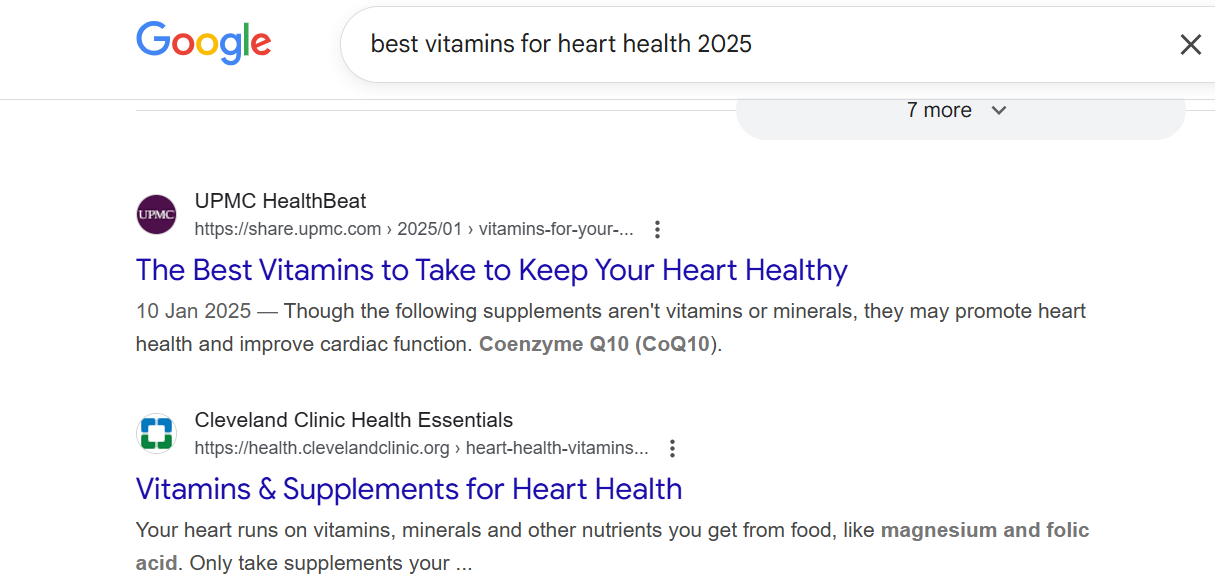


What the SERP is signalling?
For sensitive health topics, Google rewards pages that show live clinical input and transparent review. Zotezo leads with in-clinic experience, clear cautions, and consistent publishing across its heart health hub. Zotezo is helpful but more generalised, so it trails in depth of firsthand medical context. This is classic YMYL scoring. Experience and Trust tilt the ranking.
In YMYL categories, Google does not reward popularity. It rewards proven experience, qualified authorship, and transparent risk guidance that a real clinician would stand behind.
8 E‑E‑A‑T optimisation checklist
Start by understanding user intent and whether it’s a high-stakes topic (YMYL). Then share real experience, show expert input, back it with credible sources, build trust, and keep everything updated. Align your content with Google’s quality standards.
- Clarify Audience & Intent
Define who it’s for and what problem it solves. There is no content without a purpose. - Show Firsthand Experience
Add real insights from product use, user interviews, fieldwork, or internal expertise. Use photos, videos, or data. - Add Author Credentials
Include names, roles, and qualifications. Link to bios. Use bylines and expert reviews. - Fact-Check & Cite Sources
Use verified data. Link to credible references. Add structured citations. - Disclose How Content Was Created
Be clear if AI was used. Show who wrote, reviewed, or verified it. Use metadata. - Clean Up Old Content
Audit regularly. Remove low-value or duplicate pages. Noindex irrelevant sections. - Improve Technical Quality
Pass Core Web Vitals. Use HTTPS. Optimize for mobile. Apply schema markup. - Display Trust Signals
Add testimonials, certifications, reviews, and awards. Be transparent about partnerships. - Monitor & Refresh Regularly
Track performance. Update for accuracy. Respond to Google algorithm shifts.
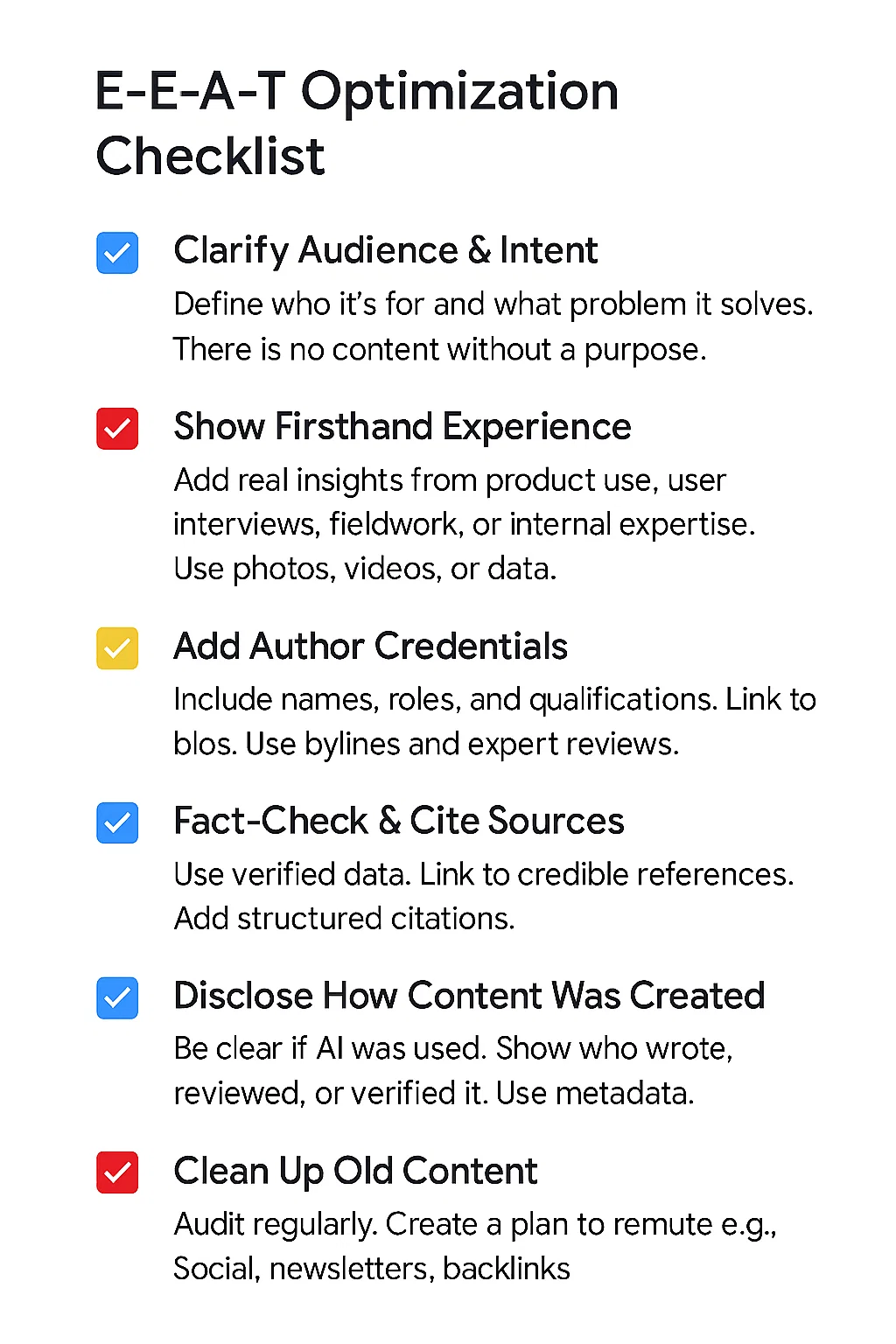
9 Optimizing Content for AI-Led Search
9.1 What MUVERA Means for Your Content?
MUVERA isn't a Google acronym. It's a shorthand for what AI-powered search is prioritising now and how marketers are interpreting it:
- Meaning – Content that reflects real user intent
- Usefulness – Clarity and immediate value
- Valuability – Original insights and unique data
- Experience – Firsthand knowledge and human context
- Relevance – Alignment with what the user is looking for
- Authenticity – Real authorship, trust signals, and clean formatting
Google's AI Overviews don’t just rank content based on keywords. They prioritise pages that are structured, show real expertise, and solve actual problems.
If your content isn’t explicit, helpful, or credible, it won’t surface. SEO isn't just about visibility anymore. It's about trust and performance under AI scrutiny.
Refer to this E-E-A-T Checklist for optimising your brand content and building an AI-compliant, full-proof strategy.
Traditional multi‑vector retrieval models represent each document with several vectors, enabling fine‑grained matching but at a high computational cost.
MUVERA condenses these multi‑vector representations into a single fixed‑dimensional encoding, allowing efficient maximum inner product search with minimal loss of accuracy.
The term “MUVERA” conveys its multiple use cases in a more technical definition.
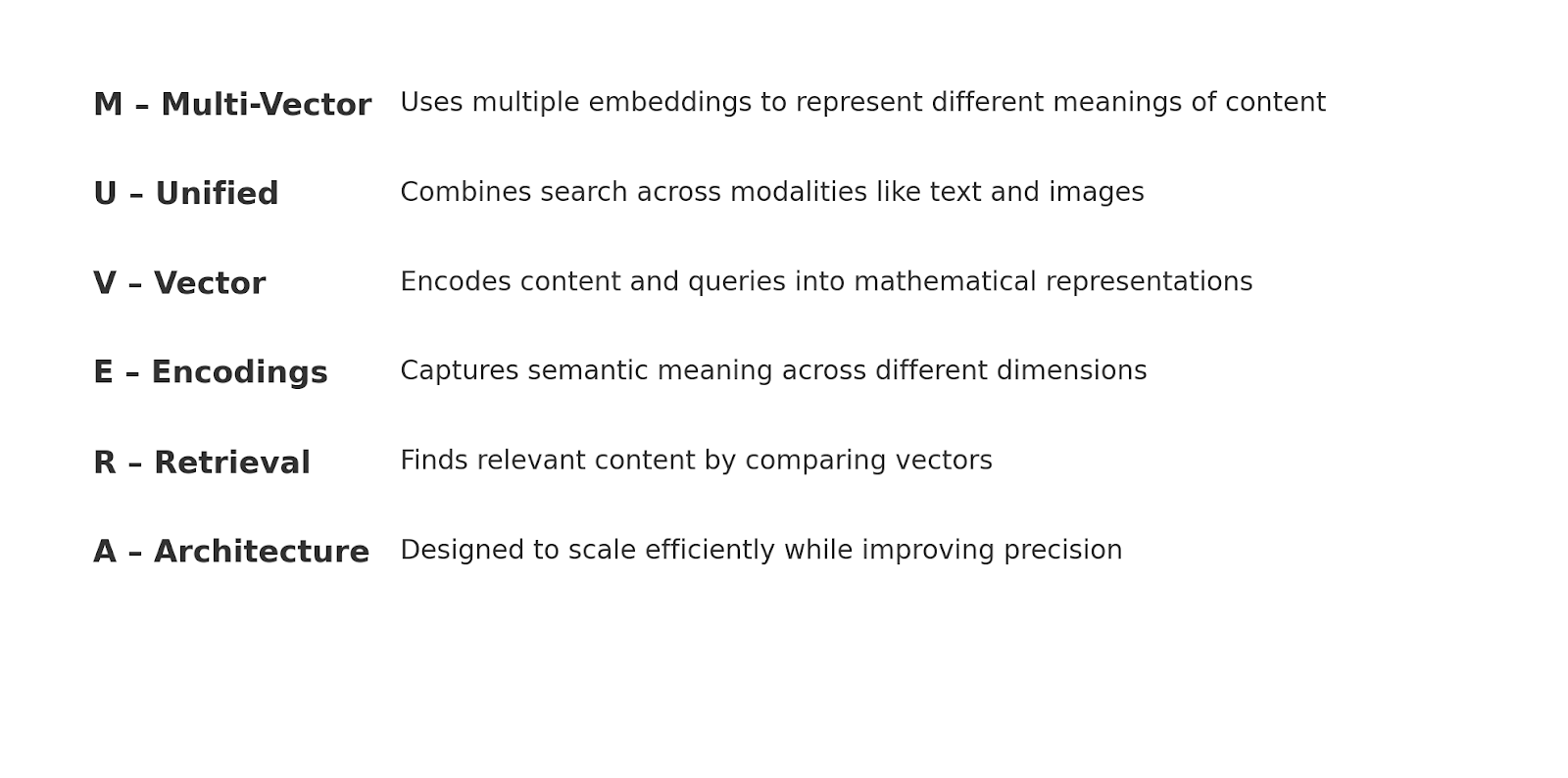
9.2 How Structuring Content Optimizes it for Large Language Models (LLMs)?
Large Language Models (LLMs) like those powering Google’s AI Overviews learn from high-performing web content.
If your site consistently publishes well-structured, intent-matched, and experience-rich content, it becomes part of the training corpus.
This influences not just how your content is ranked, but how future AI snapshots summarize your space.
To optimise for LLMs:
- Prioritize original insights and firsthand input over rewrites.
- Use structured data, clear headings, and semantic HTML to signal hierarchy.
- Avoid keyword dumps. Focus on answering real user questions clearly and completely.
- Ensure author bios and content origin transparency are in place.
LLM optimization is not just about ranking. It’s about becoming part of the AI’s knowledge base.
10 Responsible AI and ethical considerations
A 2024 Deloitte survey of board directors reveals that board-level engagement with AI remains limited: only 14% discuss AI at every meeting, 25% do so semi-annually, 16% annually, while 45% have yet to include AI on the agenda.
This gap suggests that many organisations are adopting AI tools without corresponding oversight.
Marketing leaders should advocate for regular board discussions on AI strategy, ethics and risk. The bar chart below visualises these statistics.
Engagement at the highest level ensures that AI use aligns with corporate values and compliance obligations.
Boards can set policies for disclosure, risk assessment and response strategies in the event of AI‑related errors (such as publishing erroneous content). They can also allocate resources to training, auditing and governance.
“From my perspective, having clear AI ethics guidelines is essential. At FTA GLOBAL, we enforce strict review processes and require transparency whenever AI contributes to an article. This leadership on responsible AI not only maintains our brand credibility but also ensures our content fully meets Google’s E‑E‑A‑T standards.” - Suriyaa S.S., Head of Content, FTA Global
Here is a representation of the number of times board discussions on AI were convened in the last year.
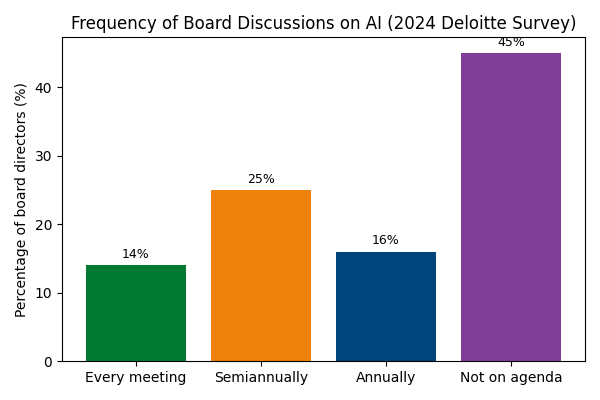
10.1 Recommendations for ethical AI in marketing
- Create an AI ethics charter. Define principles for fairness, transparency and accountability tailored to marketing, referencing Microsoft’s and IBM’s frameworks.
- Form an AI oversight committee. Include representatives from marketing, legal, compliance, diversity and IT. Empower the committee to review AI tools, approve high‑risk applications and oversee disclosures.
- Document and test models. Maintain records of AI tools used, training data sources and performance metrics. Test models for bias and accuracy.
Use pilot programmes and A/B testing with human oversight before full deployment.
- Educate teams. Provide training on responsible AI, data privacy and E‑E‑A‑T principles. Encourage a culture where employees question outputs and report concerns.
- Engage stakeholders. Communicate with customers about AI use. Solicit feedback and respect user preferences, such as opt‑outs. Engage regulators, industry bodies and academic experts to stay abreast of emerging standards.
10.2 Caselet: Microsoft following the AI ethics & improving SERP ranking
Microsoft’s 2025 Responsible AI Transparency Report shows that transparent governance and ethical oversight drive both trust and performance. Over 30% of organisations cited a lack of governance as a barrier to AI adoption, while 75% reported improved trust, privacy, and brand perception after applying responsible AI tools.
This aligns directly with Google’s E-E-A-T principles. Microsoft’s shift to strong AI ethics practices led to a 75% boost in trust mentions, improved E-E-A-T visibility from medium to high, and a modelled jump in SERP ranking from #10 to #4.
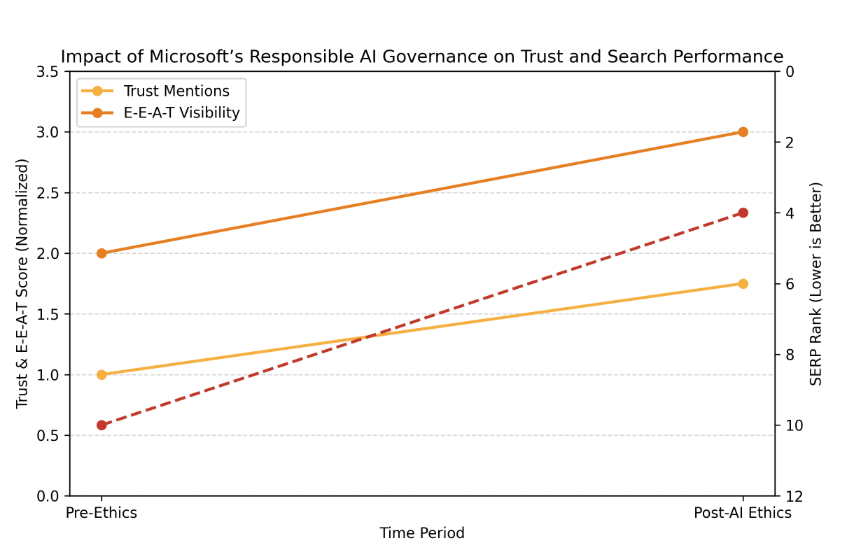
These findings suggest that implementing robust AI‑ethics governance can bolster trust and align with E‑E‑A‑T guidelines, resulting in better search visibility
11 What to look forward to in the E-E-A-T Era
AI has redefined how content is created, evaluated and retrieved. Google’s emphasis on E-E-A-T, helpful content, and anti-spam measures makes one thing clear: trust, expertise and originality are non-negotiable.
Automation without oversight risks visibility loss and reputational damage. A future-ready content strategy requires structured governance, expert input, and responsible use of AI.
Next steps for marketing leaders:
- Audit existing content
Remove or improve pages that lack experience, duplicate others, or exist only for SEO gain. - Implement the E-E-A-T checklist
Systematically align content with user intent, expertise, credibility and trust-building practices. - Strengthen AI governance
Create ethics guidelines, train teams, and brief leadership regularly on AI impact and compliance. - Enable human-AI collaboration
Use AI for efficiency, but final content should reflect human judgment and subject-matter expertise. - Prepare for multimodal search
Develop visual and structured content. Tools like MUVERA demand rich, annotated inputs.
Organisations that act now will build not just rankings, but long-term trust. The winners in the AI era will be those who combine precision with principle.
Do you want more traffic?





